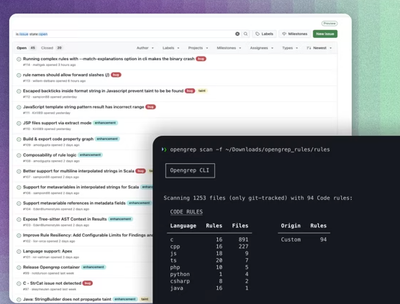
Research
Security News
Lazarus Strikes npm Again with New Wave of Malicious Packages
The Socket Research Team has discovered six new malicious npm packages linked to North Korea’s Lazarus Group, designed to steal credentials and deploy backdoors.
@simpleview/cms-component-library
Advanced tools
Simpleview CMS Component Library
Quickstart - A guide to setting up the repo
NPM Scripts - A list of scripts available in the package.json
Repo Structure - An guided explanation of the repo stucture
Unit Testing Overview - Overview and example of unit testing with Jest
Storybook Stories Overview - Overview and example of stories in Storybook
NPM Package - Deploying the npm package
References - A list of useful links and resources, including snippet information
Install NodeJS
curl -fsSL https://deb.nodesource.com/setup_lts.x | sudo -E bash -
sudo apt-get install -y nodejs
Clone this repository to your local machine
git@github.com:simpleviewinc/cms-component-library.git for the URL. This will use your global GitHub user keys setup during the sv-kubernetes setup.git clone git@github.com:simpleviewinc/cms-component-library.gitcd D:/cms-30 # or whichever folder you are saving this in
git clone git@github.com:simpleviewinc/cms-component-library.git
Install Dependencies
cd cms-component-librarynpm installcd cms-component-library
npm install
Configure VS Code
Download the ESLint extension for VS Code.
Open your command palette (Ctrl+Shift+P on Windows and Cmd+Shift+P on Mac) and search for settings. Select the "Preferences: Open Settings (JSON)" option.
Add the following JSON block to your settings.json file:
"eslint.validate": [
"javascript",
"javascriptreact",
"typescript",
"typescriptreact",
],
"editor.codeActionsOnSave": {
"source.fixAll.eslint": true,
},
Start Storybook
Storybook is the main method of local testing.
cd cms-component-librarynpm run storybookhttp://localhost:6006 on your local machinecd cms-component-library
npm run storybook
A list of the scripts available via package.json and their functions. Scripts are run via the command npm run [script]
storybook: Starts up Storybookbuild-storybook: Builds storybook for production (GitHub Pages)code-quality: Run type-check, lint, and prettiertype-check: Run TypeScript against all code to check for type errorslint: Lint all code, fix anything that can be fixed by eslint in the processprettier: Format all code, overwrite filestest: Run all testsbuild: Build NPM Package to dist folderpublish: Publish NPM release.storybook: Configuration for Storybook.vscode: Global snippets__MOCKS__: Jest mocks, used to stub out API or filesystem calls - Learn Moresrc: Main source code path
index.tsx: Main export for NPM package, if a component is not exported here, it won't be in the NPM package (More on NPM below)components: React components and their corresponding CSS files
ComponentName/ComponentName.tsx: The component itselfComponentName/ComponetName.spec.tsx: Tests for ComponentName component (More on tests below)ComponentName/ComponentName.stories.tsx: Stories for ComponentName componet. (More on stories below)ComponentName.module.css: CSS styles for ComponentNamestories: Storybook Introduction and stories not tied to a component
Introduction.stories.mdx: The intro page of storybook that outlines the storybook structureassets: Assets for the introduction story and others not tied to specific componentsdocumentation: Stories not tied to specific components, typically to display foundation stylingstyles: Global CSS files
global.css: Globally scoped CSSnormalize.css: Cross-browser default styles rebootfoundations.css: Global CSS variables (will be replacing swatches.css in the future)swatches.css: Global CSS variables (formerly variables.css)hooks: Path for all custom hookstypes: Path for all shared typeslib: Old SV libraries converted to TypeScriptutils: Generic re-usable utilities.eslintrc.yml: ESLint configuration.prettierrc: Prettier configurationjest.config.ts: Jest configurationjest.setup.ts: Jest setup (runs before all tests)We use Jest and React Testing Library to unit test every component. We also include jest-axe unit tests in every component test suite for basic accessibility coverage.
Unit tests are saved as ComponentName.spec.tsx
As an example of a basic test, here we are testing the Link component using the getByText query:
import React from 'react';
import { render } from '@testing-library/react'; // react-testing-library
// We do not need to import Jest, when we run tests
// it is Jest that runs these files, so all Jest
// functions are implicit
import Link from '../Link'; // This is the component we are testing
import { axe, toHaveNoViolations } from 'jest-axe'; // Jest-axe provides basic testing for common accessibility issues
expect.extend(toHaveNoViolations); // This adds the jest-axe custom Jest matcher to check for accessibility issues
// We start with `describe`, we are describing our Link component
describe('Link Component', () => {
// We expect that `it` `Renders Correctly`, you can have
// multiple `it` blocks if your component is more complex
// and requires testing different scenarios
it('Renders Correctly', () => {
// Here we are defining some variables to use as props
// for the component
const to = {
url: 'https://simplevieweinc.com/',
target: '_blank',
};
const childText = 'test text';
// This is an extra prop, we also want to make sure they are tested,
// check the Link component to see where the extra props are passed
const rel = 'noopener noreferrer';
// We get any queries we want to use (`getByText` here) from the
// `render` function of react-testing-library, and pass in our
// component with the mock data above, check the documentation
// for react-testing-library for more available queries
const { getByText } = render(
<Link
to={to}
rel={rel}
>
{childText}
</Link>,
);
// We should see the test within `childText` in the rendered component
const linkElement = getByText(childText);
// We expect to have found the element rendered by our component
expect(linkElement).toBeDefined();
// We expect the `target`, `href`, and `rel` attributes to be
// added to the element as defined by the Link component. Check
// the Jest documentation for more on `expect` Matchers.
expect(linkElement).toHaveProperty('target', to.target);
expect(linkElement).toHaveProperty('href', to.url);
expect(linkElement).toHaveProperty('rel', rel);
});
// A version of this test is added to every compoonent's unit tests
// to ensure that there are no testable accessibility (a11y) violations
// utilizing jest-axe's `.toHaveNoViolations()`.
it('should not have any testable a11y violations', async () => {
const { container } = render(
<WrapLink
link={{
url: '/',
}}
data-testid='wrap-link-test'
>
Test Text
</WrapLink>,
);
const results = await axe(container);
expect(results).toHaveNoViolations();
});
});
Storybook is an open source tool for building UI components and pages in isolation. It streamlines UI development, testing, and documentation.
We use Storybook to document our components. Storybook auto-generates documentation from comments in the component code, so it's crucial to add clear and contextual comments directly in the component files, not in the story files.
An example of the Docs page for the Link component
Here is an example showing the comments for the Link component's props that are automatically converted to Storybook Docs:
export type LinkProps = {
/**
* The `to` object specifies the URL to link to, and optionally a target that specifies where to open the linked document.
*/
to: LinkAsset;
/**
* The target attribute specifies where to open the linked document, overriding the `target` key in the `to` object.
*/
target?: '_self' | '_blank' | '_parent' | '_top';
}
In the above code example, the LinkProps will automatically render like this:

NOTE: In the above code example the comment
/** **/that is directly above the prop is used in Storybook as documentation for that prop. Storybook will be able to auto-detect the type and default (most of the time).
After the props are declared, the component description should be added that explains the general purpose or function of the component as well as any helpful clarifications. This will also display at the top of the Storybook Doc.
Here's an example below of the comments for the Link component. If you visit the Link component in Storybook you can see these comments translated into the Link description at the top of the page.
/**
* The Link component is used to trigger an action or event where the primary intention is navigation.
*
* The `target` property can be specified in two places, either as a property of the `to` object, or
* as a prop on the Link component itself. If both are specified, the `to` object is ignored.
* This way, you can override the target without modifing the `to` object.
*/
Stories are saved as ComponentName.stories.tsx
Here is an example of a story for our Link component:
import React from 'react';
import { Link } from '../components';
// The title here translates to the story `Link` in the `UI Controls` folder
export default {
title: 'UI Controls/Link',
component: Link,
};
// Render the Link component
const Template: StoryFn<typeof Link> = (args) => {
const { children } = args;
return <Link {...args}>{children}</Link>;
};
// `Standard` is a layout displayed in Storybook,
// we can define multiple layouts if needed (e.g. `SecondStandard`).
// The args passed to primary are the props
// that the rendered component will receive.
export const Standard = Template.bind({});
Standard.args = {
to: {
url: '/',
target: '_self',
},
target: '_self',
variant: 'link',
children: 'I am a link',
};
// `SecondStandard` is an additional layout displayed
// in Storybook, that uses the same Template as `Standard`,
// but with it's own unique props.
export const SecondStandard= Template.bind({});
Standard.args = {
to: {
url: '/',
target: '_blank',
},
target: '_blank',
variant: 'link',
children: 'I am a second link',
};
See the NPM Release Documentation for instructions on deploying new versions to NPM.
We have included some helpful boilerplate snippets for VSCode users.
There are currently the following named snippets:
svcomponent - the boilerplate for a new componentsvtest - the boilerplate for a new Jest test suitesvstory - the boilerplate for a new Storybook storyTo use these snippets:
NewComponent.tsx, NewComponent.spec.tsx, NewComponent.stories.tsx respectively)TabComponentName, if neededFAQs
Simpleview CMS Component Library
The npm package @simpleview/cms-component-library receives a total of 62 weekly downloads. As such, @simpleview/cms-component-library popularity was classified as not popular.
We found that @simpleview/cms-component-library demonstrated a healthy version release cadence and project activity because the last version was released less than a year ago. It has 0 open source maintainers collaborating on the project.
Did you know?

Socket for GitHub automatically highlights issues in each pull request and monitors the health of all your open source dependencies. Discover the contents of your packages and block harmful activity before you install or update your dependencies.

Research
Security News
The Socket Research Team has discovered six new malicious npm packages linked to North Korea’s Lazarus Group, designed to steal credentials and deploy backdoors.

Security News
Socket CEO Feross Aboukhadijeh discusses the open web, open source security, and how Socket tackles software supply chain attacks on The Pair Program podcast.

Security News
Opengrep continues building momentum with the alpha release of its Playground tool, demonstrating the project's rapid evolution just two months after its initial launch.